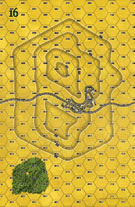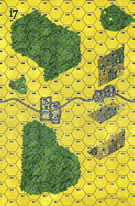|
Delay Grossdeutschland 1946 #4 |
||
|---|---|---|
| (Attacker) Germany | vs | Soviet Union (Attacker) |
| Formations Involved | ||
|---|---|---|
| Germany |  |
Grossdeutschland Air-Landing Brigade |
| Soviet Union |  |
9th "Bobriusko-Berlinskaya" Tank Division |

|
| Overall Rating, 1 vote |
|---|
|
5
|
| Scenario Rank: --- of 957 |
| Parent Game | Grossdeutschland 1946 |
|---|---|
| Historicity | Alt-History |
| Date | 1946-08-01 |
| Start Time | 09:00 |
| Turn Count | 20 |
| Visibility | Day |
| Counters | 182 |
| Net Morale | 1 |
| Net Initiative | 2 |
| Maps | 4: 15, 16, 17, 8 |
| Layout Dimensions | 112 x 43 cm 44 x 17 in |
| Play Bounty | 200 |
| AAR Bounty | 166 |
| Total Plays | 1 |
| Total AARs | 1 |
| Battle Types |
|---|
| Delaying Action |
| Exit the Battle Area |
| Inflict Enemy Casualties |
| Meeting Engagement |
| Scenario Requirements & Playability | |
|---|---|
| Eastern Front | Maps |
| Grossdeutschland 1946 | Base Game |
| Road to Berlin | Maps + Counters |
| Introduction |
|---|
|
Mobile formations became "fire brigades" on the Eastern Front because of their ability to move quickly to the site of an enemy break-through. A unit that could move even more quickly than an armored division, and was not bound to the road network, would have been even more useful in holding defensive lines. |
| Conclusion |
|---|
|
The helicopter would become an important battlefield weapon in the decades that followed World War II, thanks to its incredible mobility. But it remains today very vulnerable to ground fire and even home-made devices. NATO planners certainly hoped they could stop Soviet tank divisions with elite light infantry formations armed with antitank missiles and moving by helicopter; the earliest rotary aircraft would undoubtedly have been pressed into the same role. |
| AFV Rules Pertaining to this Scenario's Order of Battle |
|---|
|
| 1 Errata Item | |
|---|---|

|
The morale and combat modifiers of German Sergeant #1614 should be "0", not "8". (Shad
on 2010 Dec 15)
|
| ...or in this case: Annihilation | ||||||||||||
|---|---|---|---|---|---|---|---|---|---|---|---|---|
IntroductionAugust, 1946 - Hypothetical The main objectives: Soviet objective is to exit to the west and inflict casualties along the way. Germans are trying to stop them and inflict some damage of their own. Time = 5 hours (20 turns) Opening Thoughts The Germans are completely outnumbered and start off map?! They will need to race on board as quickly as possible and set up a defensive line. They have very few AT units and no armour. The Soviets have a lot of tanks. How can they stop them? I envision the Soviet armour breaking through the German line and continuing almost unimpeded. What I forgot about was the combination of the X7 rocket infantry with the mobility of helicopters… BATTLE SUMMARYThe German copters advance across the map heading for the high ground. The Soviet’s entry is hampered by a single meandering road and so many troops they can’t even all make it on board in turn 1! The Germans line up and disembark to meet the oncoming Soviet column. The German 282P helicopters pick off the Soviet M3s with their anti-tank missiles killing some leaders and completely disrupting the Soviet chain of command. Some other copters strafe some unexpecting infantry and score a 2X. The Soviet Colonel is KIA and 2 units desert. The decapitation halts the Soviet advance at a bottleneck between woods and some fields and the Soviet infantry advance is blocked X7 Rockets begin to fire on the approaching armour and the T-34c tanks are hammered (losing 7 steps!) Helicopters are used to relocate the X7 in the north. At the end of the first round of combat the Soviets are already licking their wounds having lost the equivalent of 28 steps! In the south the Germans win initiative and the T-34c tanks take another round of rockets. The Soviet armour manages to overrun one German STRM but they take heavy losses due to their low morale. The helicopters begin taking a few losses the road is completely clogged by the decapitation. The Soviet armour tries to squeeze through the German line but they have no chance against the X7 rockets. The helicopters continue to harass the Soviets and roll an uncanny number of lucky strikes (11s and 12s). Soviet artillery is unable to shake the X7 who are aided by great leaders and strong morale. Soviet AA Gun takes down their first helicopter. Germans win initiative again and blow most of the remaining Soviet armour away. The copters move to harass the Soviet artillery as the AA Guns try to cover them. The first X7 is lost to Soviet artillery fire. Only 90 minutes have passed. A second X7 is eliminated by some Soviet artillery as other artillery crews flee under helicopter fire. After turn 7, it already looks over for the Soviets. Over the next hour the German line continues to hold as the Soviets are continuously hammered and harassed. Soon they are down to two officers and with severe casualties and very limited ability to combat move they resign. GERMAN MAJOR VICTORY AftermathWow, what a great battle! I usually play my battles to full completion but after the 11 turns this pretty much was reduced to the German helicopters knocking out demoralised infantry at close range as the dug-in HMGs hail fire on anyone able to advance. The lack of remaining leadership meant that with a few targeted attacks the Soviets would soon be completely hamstrung. I completely underestimated the German strength. I knew the morale differential (8/8 to 7/6) would be tough on the Soviets (once reduced/demoralised, they’d have a hard time recovering. Particularly as leader modifiers were almost non-existent). Consequently, I could have played the Soviets much better by having a slower advance and having the armour wait for the infantry in a more coordinated attack. As it happened the “roadblock” formed by the decapitated Soviet infantry completely cut off the armour from support which was hammered by the deadly X7 rockets. The combination of the X7 with helicopters was unbelievably brutal. They could race around the hills and deposit their men wherever they wished. When the armour tried to flank the German line, the X7s would just quickly reposition themselves. With higher initiative, the Soviets would then be walloped the following turn. I was amazed at how a few infantry and helicopters completely stopped the Soviet advance. This scenario definitely warrants a replay and it was completely engaging. Scenario Rating: 5/5 – A small but superior force faces a weak-willed giant. Fantastic scenario. |
||||||||||||
| 0 Comments |

 Gr46003
Gr46003 































